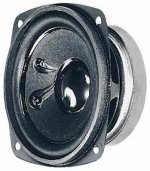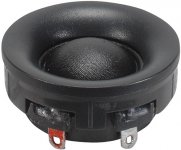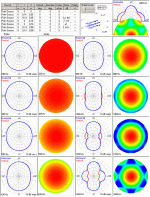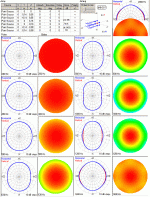Re: One more thing....anf then, I'll shut up.
Please don't reduce the frequency and enthusiasm of your posts because of a few naysayers. I find your posts to be incredibly entertaining reading. It would be a shame if you did not continue to do so.
I guess my only confusion would be one of the ingredients in this fantastic recipe for sound that you mentioned twice above. A sound meter. What is it's function in the design?
cheers,
AJ
Zarathu said:Now I'll be quiet.
Zarathu
Please don't reduce the frequency and enthusiasm of your posts because of a few naysayers. I find your posts to be incredibly entertaining reading. It would be a shame if you did not continue to do so.
I guess my only confusion would be one of the ingredients in this fantastic recipe for sound that you mentioned twice above. A sound meter. What is it's function in the design?
cheers,
AJ
http://www.visaton.de/de/chassis_zubehoer/breitband/frs8_8.html
There is also a FRS 8 M with bigger magnet and higher SPL - it cost around 10EUR and shouldnt be hard to find
If a line array - how about making it 2.5way with subs ???
There is also a FRS 8 M with bigger magnet and higher SPL - it cost around 10EUR and shouldnt be hard to find
If a line array - how about making it 2.5way with subs ???
Attachments
This cheap Dayton is available in Germany - ND16FA-6 or ND20FA-6
What is uncertain to me is if the benefits from line array are such that they compensate fore the use of such cheap drivers ????
Even if cheap drivers are used, it will cost serious money - the only reason I havent tried it yet - I prefer to build my own ribbon
What is uncertain to me is if the benefits from line array are such that they compensate fore the use of such cheap drivers ????
Even if cheap drivers are used, it will cost serious money - the only reason I havent tried it yet - I prefer to build my own ribbon

Attachments
This one got me excited!
For instance if I choose to go with the "circular array" idea with a tweeter in the middle, that wouldn't be very much like a line array at all, but would I still have to worry about cancellations?
Hi Magnus,
My 2 cents of circular array (7 drivers ) thoughts:
It’s possible to design a good sounding well-behaved circular array as the dispersion from such an array below driver c-c = lambda/4 is smooth and symmetrical and both the horizontal dispersion = the vertical will be stable down to a few feet or to infinity listening distances.
One bonus that follows ‘circular arrays’, is that the polar pattern directivity beginning is earlier when compared to one driver of similar gross size, occurring at about 400-500 Hz for 3 “ drivers.
This speaker have a somewhat magnified central phantom if crossed over at 1 kHz, with a proportional closer appearing soundstage but not as disturbed with midrange reflexes from the adjacent walls as the case is when comparing with a single FR driver.
Lowering the crossover frequency improves overall phantom sharpness and moves the size of the central phantom back to normal (single driver size) when approaching 250 Hz from about 500 Hz where apparent size dependent diminishing returns are reached.
Preferably, the crossover division should be at most up to a quarter wavelength for any circular array based on the ‘circular’ c-c distance.
See the submitted example of a simulated circular array made up with 7 equal sized equal polarity drivers of 3” when crossed over at 1 kHz 12 dB/octave LR and at 800 Hz 24 dB/octave LR and compare.
The middle positioned driver should be of a sonically good quality FR driver and the other 6 3” drivers T/S parameters are chosen to reach mid bas range upper FR extension at about 80 Hz.
For first shown polar plots, the attenuation of the LR 12-dB/octave filter at 1 kHz and considered too low, as lambda/4 equals 1062 Hz for an 8.1 cm driver.
If moving further a bit down to 800 Hz and by the use of a 24dB/octave LP filter instead changes everything to the better and if crossing over about 700 Hz the dispersion is close to optimal.
When extrapolation to other sized divers, the crossover must be recalculated and e.g. lowered if a larger diameter drivers are in question i.e. if 4” drivers are used instead, then the crossover must be 4/3 times lower i.e. 3/4x800 Hz = 600 Hz at max.
b
1(2)
Attachments
Tinitus,
"What is uncertain to me is if the benefits from line array are such that they compensate fore the use of such cheap drivers ????"
These are common misconceptions and ones which commercial manufacturers like Selah like to propagate. You must use $55 ribbon tweeters, and $70 mid woofers to have a quality system. This is true for point source speakers where one tweeter covers the whole right channel, and one mid range covers the whole mid range. Even so my last Point source design used a high quality $30 tweeter, and a high quality $45 mid range, and when I wanted to listen to them at full volume they never failed to sound strained or to buzz and vibrate. And for certain kinds of music like piano and pipe organ they simply failed to do the job.
Cheap is a relative term, and by its use in English it implies: poorly made, bad design, barely usable. The appropriate term to use is "less expensive." If you go to Zaph Audio, you can see the FR and distortion information regarding it. Here you will see that the word cheap is highly inappropriate. The FR matches many tweeters much more expensive, as does the distortion measurements.
But the bottom line is that a line array offers something that a point source speaker cannot offer.
1. In the distortion measurements, what the waterfall graph says it what you get. However, distortion is a non-linear measure of the amount of signal you feed to the speaker. The lower the signal level, the lower the distortion level for all speakers. With a line array like mine, the inexpensive tweeters each have to cover only 3.2% of the total tweeter volume, and the midranges only 5.8% of the total range. Distortion drops through the floor, and with it clarity and detail rise dramatically.
2. FR has a similar circumstance. Speakers are measured typically at 1 watt at 1 meter. This is fairly loud with many speakers. They are not measured at .06 watt at 1 meter(the sensitivity of a line array is typically 12 full decibels above what they are singly---my inexpensive tweeters are 92 singly, and 106 in a group). All speakers have a pretty flat frequency response at very low volume levels
3. Sensitivity rises dramatically. people might wonder what this does. I leave that to you
"Even if cheap drivers are used, it will cost serious money - the only reason I haven't tried it yet - I prefer to build my own ribbon."
Clearly you have your own reasons, and they have nothing to do with serious money.
I already stated in a previous post the 4 things that you get with a line array that you don't have with even the best of the point source speakers.
But I've also stated the requirements as being more precise when you are using budget speaker designs: you must use electronic crossovers and tri amping, and YOU MUST NOT CROSS IN THE CRITICAL 300-3000hz frequency range. If you follow these requirements and use less expensive designs you will have a system that matches the best available.
People's mouths will drop open when they come into your room.
Zarathu
PS: the model you showed is inappropriate for a line array using DOME tweeters since the c-to-c distance is over 1 inch.
"What is uncertain to me is if the benefits from line array are such that they compensate fore the use of such cheap drivers ????"
These are common misconceptions and ones which commercial manufacturers like Selah like to propagate. You must use $55 ribbon tweeters, and $70 mid woofers to have a quality system. This is true for point source speakers where one tweeter covers the whole right channel, and one mid range covers the whole mid range. Even so my last Point source design used a high quality $30 tweeter, and a high quality $45 mid range, and when I wanted to listen to them at full volume they never failed to sound strained or to buzz and vibrate. And for certain kinds of music like piano and pipe organ they simply failed to do the job.
Cheap is a relative term, and by its use in English it implies: poorly made, bad design, barely usable. The appropriate term to use is "less expensive." If you go to Zaph Audio, you can see the FR and distortion information regarding it. Here you will see that the word cheap is highly inappropriate. The FR matches many tweeters much more expensive, as does the distortion measurements.
But the bottom line is that a line array offers something that a point source speaker cannot offer.
1. In the distortion measurements, what the waterfall graph says it what you get. However, distortion is a non-linear measure of the amount of signal you feed to the speaker. The lower the signal level, the lower the distortion level for all speakers. With a line array like mine, the inexpensive tweeters each have to cover only 3.2% of the total tweeter volume, and the midranges only 5.8% of the total range. Distortion drops through the floor, and with it clarity and detail rise dramatically.
2. FR has a similar circumstance. Speakers are measured typically at 1 watt at 1 meter. This is fairly loud with many speakers. They are not measured at .06 watt at 1 meter(the sensitivity of a line array is typically 12 full decibels above what they are singly---my inexpensive tweeters are 92 singly, and 106 in a group). All speakers have a pretty flat frequency response at very low volume levels
3. Sensitivity rises dramatically. people might wonder what this does. I leave that to you
"Even if cheap drivers are used, it will cost serious money - the only reason I haven't tried it yet - I prefer to build my own ribbon."
Clearly you have your own reasons, and they have nothing to do with serious money.
I already stated in a previous post the 4 things that you get with a line array that you don't have with even the best of the point source speakers.
But I've also stated the requirements as being more precise when you are using budget speaker designs: you must use electronic crossovers and tri amping, and YOU MUST NOT CROSS IN THE CRITICAL 300-3000hz frequency range. If you follow these requirements and use less expensive designs you will have a system that matches the best available.
People's mouths will drop open when they come into your room.
Zarathu
PS: the model you showed is inappropriate for a line array using DOME tweeters since the c-to-c distance is over 1 inch.
AJ in Fla,
Hope you're not in the path of the forest fires.
A sound meter is a cheap way of balancing the line array system. A better way is a calibration mic, and some software.
But an easier way is to do it in a way that you actually like. Its misunderstood that everybvody hears the same. They don't. Each of us has a different percentage of lows, highs, mids that we hear compared to someone else. What better way with tri-amping than to balance the various lines in the array in a way which is pleasing to your specific ability to hear the lows, mids, and high treble.
Right now with Tinnitus, and sinus cogestion, my left ear is much worse than my right, in FR and volume.
Zarathu
Hope you're not in the path of the forest fires.
A sound meter is a cheap way of balancing the line array system. A better way is a calibration mic, and some software.
But an easier way is to do it in a way that you actually like. Its misunderstood that everybvody hears the same. They don't. Each of us has a different percentage of lows, highs, mids that we hear compared to someone else. What better way with tri-amping than to balance the various lines in the array in a way which is pleasing to your specific ability to hear the lows, mids, and high treble.
Right now with Tinnitus, and sinus cogestion, my left ear is much worse than my right, in FR and volume.
Zarathu
bjorno said:If moving further a bit down to 800 Hz and by the use of a 24dB/octave LP filter instead changes everything to the better and if crossing over about 700 Hz the dispersion is close to optimal.
When extrapolation to other sized divers, the crossover must be recalculated and e.g. lowered if a larger diameter drivers are in question i.e. if 4” drivers are used instead, then the crossover must be 4/3 times lower i.e. 3/4x800 Hz = 600 Hz at max.
1(2) [/B]
Very interesting! If I understand you right though, I would have to use very small woofers (3"-4") and also use a quite low crossover frequency (600-800Hz)...
In my dreams, I would use 5,25" woofers and a neat dome tweeter in the middle, but now I understand that might not be the best choice.
What about using a coaxial speaker in the middle, compared to a fullrange?
Thanks for the info!
/Magnus
Zarathu said:
I already stated in a previous post the 4 things that you get with a line array that you don't have with even the best of the point source speakers.
But I've also stated the requirements as being more precise when you are using budget speaker designs: you must use electronic crossovers and tri amping, and YOU MUST NOT CROSS IN THE CRITICAL 300-3000hz frequency range. If you follow these requirements and use less expensive designs you will have a system that matches the best available.
I have never listened to any near field line array, but from what I read and see, people seem to be very satisfied with arrays, even with "cheap" drivers.
Since I would like to (at least at first) get away with a 2-way array without subwoofer, I am looking at 5,25" drivers. The problem gets quite clear when reading James R. Griffin's excellent paper; With a woofer spacing of 130 mm, maximum crossover frequency should be 2580 Hz to avoid cancellations. To get up to 3000 Hz my calculations say max. 112 mm woofer spacing... (hard to obtain with 5,25" drivers)
So, what do you think. What would be worse? Using a crossover frequency well below 3000, or using a 130 mm woofer distance with 3000 Hz crossover frequency? I am aware that neither would be optimal, but perhaps acceptable?
/Magnus
Re: line array or "cluster"
I have the same question which I don't believe has been answered: Why isn't driver spacing a problem in D'appolito configurations?
Will this US$15K design have serious combing issues?
http://www.roundsound.com/reference-5-ls-speakers.html
maghen said:I read the paper about line arrays, and it seems more and more interesting.
I'm just curious... in line arrays I now understand the importance of having as short distance as possible between the drivers in the array (no more than one wavelength) to avoid cancellations.
Isn't this a problem in simpler speakers with "D'appolito" configuration of two drivers?
I have the same question which I don't believe has been answered: Why isn't driver spacing a problem in D'appolito configurations?
Will this US$15K design have serious combing issues?
http://www.roundsound.com/reference-5-ls-speakers.html
The above has the advantage that it can be crossed around 1khz to a 6" or 8", and thus be a simple 2way - but it gets rather expencive, as you will need a lot of them and a bunch of good 6-8" dont come cheap either - but maybe the modest priced Silver Flutes would work nice
Another option could be the use of two subs crossed highish (100-150hz)
That would allow the use of the cheap Visaton FRS8 or FRS8M at 10EUR
Still tweeters gets expencive, and dare use the real cheap ones - but according to Zaphs evaluation the small pressmount Dayton ND16/ND20 is good value at 5USD
Question is if the subs are up to the job with single drivers or if multiple drivers is needed here too
Another option could be the use of two subs crossed highish (100-150hz)
That would allow the use of the cheap Visaton FRS8 or FRS8M at 10EUR
Still tweeters gets expencive, and dare use the real cheap ones - but according to Zaphs evaluation the small pressmount Dayton ND16/ND20 is good value at 5USD
Question is if the subs are up to the job with single drivers or if multiple drivers is needed here too
Re: Re: line array or "cluster"
That's one of many examples of a system not at all fulfilling the "rules" in the paper. I guess it must be possible to build "faulty" speakers that still are very good!
For me, with a restricted budget, there are several ways to "cheat";
- shorter than optimal arrays with good drivers (will end up in the far field)
- long enough arrays with budget drivers, but too long distance between drivers (will cause "combing")
- long enough arrays with super-cheap drivers (drivers still to be found)
The question is, which wrong way is least bad?
redi said:
I have the same question which I don't believe has been answered: Why isn't driver spacing a problem in D'appolito configurations?
Will this US$15K design have serious combing issues?
http://www.roundsound.com/reference-5-ls-speakers.html
That's one of many examples of a system not at all fulfilling the "rules" in the paper. I guess it must be possible to build "faulty" speakers that still are very good!
For me, with a restricted budget, there are several ways to "cheat";
- shorter than optimal arrays with good drivers (will end up in the far field)
- long enough arrays with budget drivers, but too long distance between drivers (will cause "combing")
- long enough arrays with super-cheap drivers (drivers still to be found)
The question is, which wrong way is least bad?
bjorno said:
...
The middle positioned driver should be of a sonically good quality FR driver and the other 6 3” drivers T/S parameters are chosen to reach mid bas range upper FR extension at about 80 Hz.
...
b
1(2)
How about this for a "center driver" in the circular array?
http://www.ejjordan.co.uk/drivers/jxr6.html
(further in under "systems" there is another example of a line array that surely must be listened to in the "far field")
The Jordan is probably a very good choice
My feeling says that you might be better off with a more "normal" mounting of the bass/midbass driver, above and beneath like a MMMTMMM - xo 300-500hz or maybe with the Jordan mounted besides the midwoofers
or maybe with the Jordan mounted besides the midwoofers
Definately .... that could be a nice one
My feeling says that you might be better off with a more "normal" mounting of the bass/midbass driver, above and beneath like a MMMTMMM - xo 300-500hz
Definately .... that could be a nice one
maghen said:
How about this for a "center driver" in the circular array?
http://www.ejjordan.co.uk/drivers/jxr6.html
It may sound very good, but the thing that irks me about EJ Jordans is that from an engineering point of view, flexible aluminium cones just don't seem like a good idea. It may avoid the loud resonant peaks that stiff cones have, but what about the fatigue strength of the material?
Won't the aluminium gradually stiffen during the life of the speaker, and especially during the "break in" period?
You can harden some of the better types of aluminium with modest heat
Actually it gets softer over time - hardened aluminium do that too
but lets not hope that happens, or half the speakers of this world will be in trouble
If this Jordan really is free of peaks and breakup, its one of the rare very few - an interesting mid/tweeter with possibly low xo-point, and with a small ribbon who knows what might happen
Actually it gets softer over time - hardened aluminium do that too
but lets not hope that happens, or half the speakers of this world will be in trouble
If this Jordan really is free of peaks and breakup, its one of the rare very few - an interesting mid/tweeter with possibly low xo-point, and with a small ribbon who knows what might happen
Vagaries of speaker design = human hearing diffs
Maghen,
And its one of these characteristics that are most apparent with line array speakers. We try our best to limit any of the circumstances which might deter from high quality sound, but there is so little known about near-field line arrays(ones you put in your listening room and listen at about 8-10 feet from the speakers) that we can't b e sure what is really working and what is not.
For example:
1. the comb filtering distortion problem. The reality is that human hearing is most acute of recognizing differences between 3000 and 5000 hz. After 5000hz its pretty hard to hear differences. So comb filter distortion is more difficult to hear between 6000 and 10000. Above 10000, humans may not be able to determine whether its a loss of high or not. I try to limit the theoretical distortion to above 15,000. Quite honestly, I doubt that anyone over the age of 25 can even begin to hear that, and most of us simply cannot hear any comb filter distortion here at all. Those of us above 50 with elements of tinitus, and many of us have it for various reasons(mine being sinus congestion), simply can't at all.
2. Frequency response. Designers have the common misconception that all humans hear the same. This is completely untrue. If you were able to design a speaker system that was flat +/- 1/2 db, 20 -20khz, actual perception between humans would vary as much as +/- 10 db or more across the board.
So designing flat is really a waste of time, and it would be better to let people use a digital, phase coherent equalizer to adjust their system to their own specifications as to what they like the most.
3. Speakers themselves are not all the same. Even a small mid woofer like mine which is only 3 inches has variations in response, in dispersion, in back wave acoustic energy, in distortion, etc. When we put together a three way point source speaker, we always isolate the mid from the woofer because they are different speakers and they affect each other badly. For some reason, we seem to think that because we are using the same frequency range and the same speaker that they will all be exactly the same. Get your measurement out, and you will find that they vary very greatly. For this reason they should be completely separated from each other.
But even when they are not, people often cannot tell.
Go figure.
Zarathu
maghen said:
That's one of many examples of a system not at all fulfilling the "rules" in the paper. I guess it must be possible to build "faulty" speakers that still are very good!
Maghen,
And its one of these characteristics that are most apparent with line array speakers. We try our best to limit any of the circumstances which might deter from high quality sound, but there is so little known about near-field line arrays(ones you put in your listening room and listen at about 8-10 feet from the speakers) that we can't b e sure what is really working and what is not.
For example:
1. the comb filtering distortion problem. The reality is that human hearing is most acute of recognizing differences between 3000 and 5000 hz. After 5000hz its pretty hard to hear differences. So comb filter distortion is more difficult to hear between 6000 and 10000. Above 10000, humans may not be able to determine whether its a loss of high or not. I try to limit the theoretical distortion to above 15,000. Quite honestly, I doubt that anyone over the age of 25 can even begin to hear that, and most of us simply cannot hear any comb filter distortion here at all. Those of us above 50 with elements of tinitus, and many of us have it for various reasons(mine being sinus congestion), simply can't at all.
2. Frequency response. Designers have the common misconception that all humans hear the same. This is completely untrue. If you were able to design a speaker system that was flat +/- 1/2 db, 20 -20khz, actual perception between humans would vary as much as +/- 10 db or more across the board.
So designing flat is really a waste of time, and it would be better to let people use a digital, phase coherent equalizer to adjust their system to their own specifications as to what they like the most.
3. Speakers themselves are not all the same. Even a small mid woofer like mine which is only 3 inches has variations in response, in dispersion, in back wave acoustic energy, in distortion, etc. When we put together a three way point source speaker, we always isolate the mid from the woofer because they are different speakers and they affect each other badly. For some reason, we seem to think that because we are using the same frequency range and the same speaker that they will all be exactly the same. Get your measurement out, and you will find that they vary very greatly. For this reason they should be completely separated from each other.
But even when they are not, people often cannot tell.
Go figure.
Zarathu
- Status
- This old topic is closed. If you want to reopen this topic, contact a moderator using the "Report Post" button.
- Home
- Loudspeakers
- Multi-Way
- which loudspeaker design?







